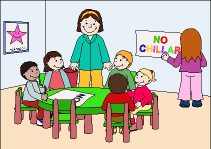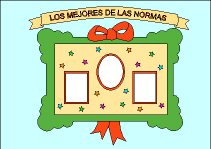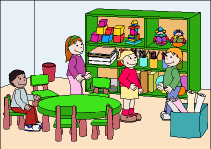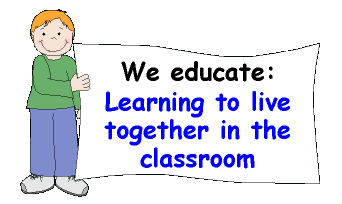|
Organized and calm coexistence in the classroom is an indispensable condition for the normal unfolding of life in the early childhood centre. It means a responsibility that not only the teachers but also the children assume that they have to pay attention to and take care of what they do or decide, within norms that are general and applicable to all. Of course this implies two important things: One, that the rules are appropriate to the characteristics of the understanding and behaviour of the children, and two, that they are followed strictly with consequences when the rules are disobeyed or ignored. Given the possibilities of the age group, the small children have to be motivated to pay attention to and take care of what they do. We have to teach them the rules that they have to follow, and to praise them when they do so, or to let them know when they breach the norms. This has to be done during any of the classroom activities, and the rules should not turn into a Decalogue of actions to be fulfilled far from the activities of their daily life. For this it is indispensable that the children assume the fulfilment of the norms as their "own commitment", and not as one that prevails as an authority symbol. The norms must be internalized by their own decision, and not imposed from outside, although it is to be expected that given the characteristics of the child age there will be frequent breaches for diverse reasons. As they learn to follow the rules, their behavior becomes a pattern and gradually become a personality trait. As an initial part of the course, or of the term, the children should be taught the norms, and the educator has to develop several activities to teach them. The parents have to know these rules, in such a way that at home they reinforce the behaviours that the school is trying to form. |
ACTIVITY
No 1 |
 |
Summary of the activity: There will be a meeting in the classroom to help them agree on the rules to be followed and to establish a commitment of everyone with respect to the rules, and to talk about how people act when they commit themselves to do something in benefit of the others. Objectives:
Procedures:
Material Resources: Typical materials for an art activity, a mural or notice board, cardboard, a cassette recorder.
Development of the activity:
2nd Part He will summarize this part after explaining that a norm is a type of behaviour that is established so that life and the stay in a place are calm, organized and harmonious, this is why it is necessary to pay attention to and take care of what we need to do to follow the norm, which is a very pretty quality, and that the people who fulfil the norms are loved and respected by all. This is why they must be children who fulfil the norms and who must carry out them well and until the end.
3rd Part With these the educator can select some rules, because an excess of norms is counter-productive and limits independence and autonomy. Whenever a child says a norm, for example "To maintain the classroom clean..." the educator will explain what the norm consists, so that each child understands what it is intended with this norm. After all the doubts in each norm have been explained, one will turn to the group voting, for which each child will raise his hand. The educator has to reinforce that once the norm is approved, each child acquires a commitment to fulfil it, and that will be praised or criticized, according to their behaviour. The educator has to record all the session, in order to extract from the recording the most important moments. We can use the recorded explanation of each norm and the approval of each one of them, to remind the children when they listen again to the recording at other times that they have made a commitment.
4th Part
5th Part |
CRITERIAL
ASSESSMENT |
|||
Observed
conduct |
YES |
NO |
Comments |
They
demonstrated to have notions on what norms are. |
|||
They
recognized how people who fulfil the norms act. |
|||
They
indicated some norms that are carried out in the classroom. |
|||
They proposed norms to be fulfilled in the classroom. |
|||
They were committed to the fulfilment of the approved norms. |
|||
| They cooperated to draw the norms that are to be fulfilled. | |||
ACTIVITY
No 2 |
 |
Summary of the activity: This activity is to organize a place in the classroom where we will set up a place of honour for the best followers of the norms. Later the educator will explain why they will create that place and finally the children will choose those who should go be in the honour list. Objectives:
Procedures: Material Resources: A mural or a blackboard, a table with an album, a table cloth, photos of the chosen children.
Development of the activity: He will make an effort so that everybody takes part in the activity of organizing the place together, thus they will clean the part of the classroom where they are going to place the photos, others will prepare cardboard frames to put the photos of the chosen children, others will make a paper table cloth to put on the table, some will help the teacher to cover and to decorate beautifully the mural where the photos and the diplomas will be hung, etc.
2nd Part
3rd Part The educator will try that the evaluations are fair. For this he could choose the children by himself, but this does not have the same educational effect as when the children guided by their educator do it. The intention is to value their own commitment that has been acquired in the previous activities. |
CRITERIAL
ASSESSMENT |
|||
Observed
conduct |
YES |
NO |
Comments |
They
fulfilled with a strong group spirit the assigned tasks. |
|||
They
participated in an enthusiastic way in the organization of the honour
site. |
|||
They
evaluated fairly the behaviour of their classmates with respect to the
fulfilment of the norms. |
|||
They mentioned the desire to in the honour board. |
|||
| They were committed to improve their behaviour so that they could be in the honour board. | |||
ACTIVITY
No 3 |
 |
Summary of the activity: The activity consists of a role play about "Our classroom". For this the educator will hold an initial conversation to invite the children to play, the game is developed and finally there is a conversation to evaluate it. Objectives:
Procedures:
Material Resources: Corner to play the child school, with the furniture, necessary equipment and materials.
Development of the activity: The children agree about the role each one will play and they take their materials and they set themselves up in their play corner.
2nd Part
3rd Part |
CRITERIAL
ASSESSMENT |
|||
Observed
conduct |
YES |
NO |
Comments |
They
performed the actions in an appropriate way. |
|||
They
needed help to play in a suitable way the actions of the different
roles. |
|||
They
developed the argument until the end of the game and introduced in
it some of the norms of the classroom. |
|||
They
knew how to give an appropriate answer to the fulfilment or breach
of the norms arisen in the game. |
|||
During the game they showed a positive attitude towards the fulfilment
of the norms |
|||
| They considered fulfilling the observed norms of the classroom during the game in their daily life. | |||


